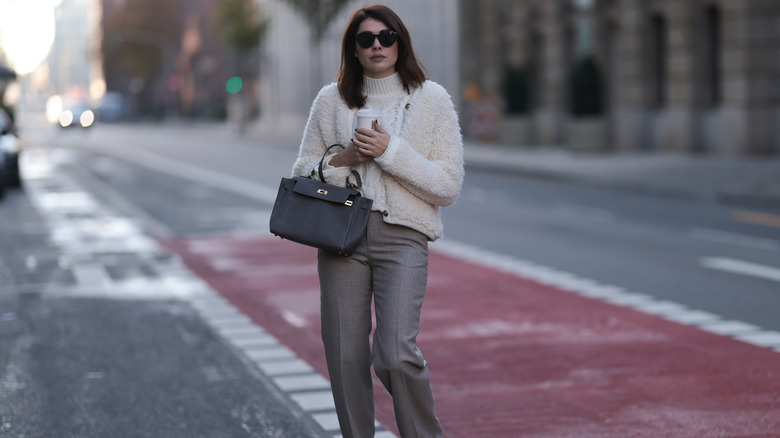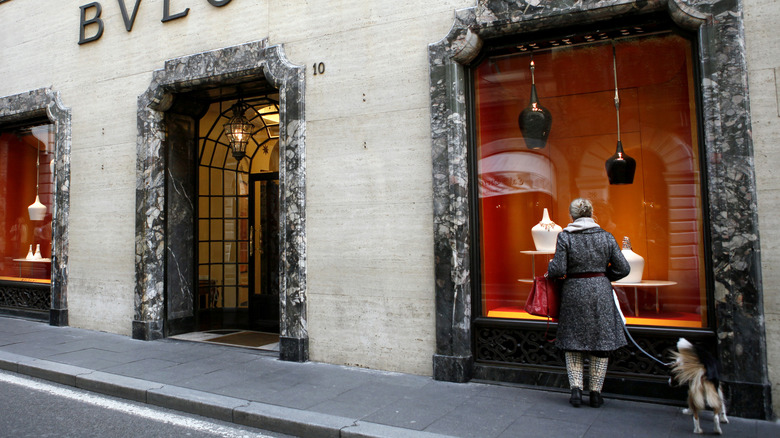The Quiet Luxury And Old Money Aesthetics Have Us Chasing An Unattainable Ideal
Income disparity in the U.S. is at a historic high but that hasn't stopped the 'stealth wealth', 'quiet luxury', and 'old money aesthetic' terms (and fashion choices) from being thrown around with increased frequency. From TV shows like Succession to the courtroom fashion of Gwyneth Paltrow, the quiet luxury aesthetic has infiltrated pop culture and heavily influenced fashion purchases. The aesthetic prides itself on minimalism with a focus on high-quality investment pieces. However, while this can absolutely be a worthwhile style (and embracing slow fashion is more sustainable), striving specifically for the stealth wealth aesthetic in the current economic climate is both ironic and toxic.
Buying into the superiority of the wealthy and striving to attain their aesthetic does nothing but further troubling classist thinking. Pursuing the appearance of a wealthy person as a non-wealthy person also furthers the unhealthy concept that wealthy people should be worshipped, exalted, and mimicked. This is especially troubling given current economic circumstances in which the wealthiest 0.01% of people have experienced a 507% income growth rate (this is five times more than the poorest 20% of U.S. households). The stealth wealth aesthetic is, and has historically always been exclusively a privilege of the wealthy. It is rooted in its exclusivity and is actively interested in keeping normal people out. Stealth wealth is oblivious to real-world problems and economics which is what makes it not just a dangerously unattainable ideal, but an aesthetic that none of us should support.
People want to look rich
The foundational element of stealth wealth lies in the aesthetic's inherent exclusivity. The premise of the look, and the people who embody it, centers around wealth signaling to other wealthy people — essentially fashion flexes with diabolically large price tags. There are no labels or outward logos, just the arrogant assumption that only those who belong to the same class will be able to recognize and know the market value of an item. Jonathan Square, Assistant Professor at Parsons School of Design, explained to Refinery29, "There would be absolutely nothing wrong with minimalism, but I think it becomes problematic when you attach superiority."
This is what makes the average person's pursuit of the aesthetic fundamentally antithetical to the point of the look. Without actually being a wealthy or old moneyed individual which is, let's face it, the cornerstone of the aesthetic's believability, any fashion choice intended to help you 'pass' as wealthy is inherently fake. This pursuit is also problematic in that it hypes the wealthy as worthy of emulation. From not paying income taxes to collecting monster bonuses while people lose their jobs, worshipping the wealthy as a non-wealthy person feels like an act of self-loathing that makes idols of villains. For instance, if the minimum wage had increased at the same rate as Wall Street bonuses, it would be $61.75 per hour instead of the federal $7.25. Wanting to emulate the aesthetics of this particular socioeconomic class extends beyond an aesthetic ideal and approaches apologist territory.
The economy behind the look
It's hard to look at the current minimalism inherent in stealth wealth and not think of 2008 recession fashion. 2008 was the last time fashion was consumed by wearable minimalism, and it was also the last time our country was on the precipice of financial collapse. Minimalism was a direct response to the economic crisis of the time and served double duty as a way for the wealthy to mute their money in the wake of those less fortunate. In this way, minimalism became a kind of costume of what wealthy people assumed regular people wear, and its trendiness in high fashion at the time was as equally out-of-touch (and vaguely insulting) as today's stealth wealth.
The other danger with this 2008 trend is that our current economic situation is on the precipice of another very similar financial crisis. In fact, researchers have found that the ratio between the average income of the top 0.1% of people in the U.S. and the bottom 90% reached Gilded Age (early 1900s) levels in the years just before the 2008 financial crisis, and we've reached this same level yet again. While our country generally sees wealth as the ultimate status symbol, the current economic climate makes that status even less attainable. Inflation, stagnated wages, and housing prices have left the vast majority of the country struggling. This has led to slowing retail growth in 2023, which is another important, if transparent, motivator for fashion brands' sudden push for expensive luxury items.
Worshipping the wealthy is unhealthy
From luxury space rockets to luxury submersibles, the news is regularly filled with garishly wealthy people spending vast sums — for some life-changing amounts — of money on increasingly outlandish short-term pursuits. Research shows that the extreme income concentration in today's society is at the same level as it was during the Roaring Twenties, and we all know how that ended. The premise of the wealthy having fundamentally better taste, style, or 'class' is not only completely false but is detrimental to the identities of average people who continue to chase an unattainable ideal, who are often made to feel bad or less than for not being exorbitantly wealthy.
That being said, it's important to note that recessions are actually good for the wealthy, as they stand to become even wealthier while the poor get poorer. Stealth wealth's focus on fewer, minimalist pieces is not rooted in a genuine concern about batting down the hatches ahead of a financial downturn. The wealthy are not facing a financial crisis in the same ways that people who are struggling to avoid homelessness while being crippled by debt are. The wealthy are merely pursuing a costume that will help them pass among regular people and they will continue to shop for luxury goods even if the rest of the country falls into poverty. This is why worshiping their aesthetic misses the core problem of stealth wealth, which is that the aesthetic is inherently interested in being superior to others.
Woman are more likely to fall victim to the stealth wealth craze
Stealth wealth might make you think of certain kinds of working professionals like Elizabeth Holmes or Steve Jobs, who share a similar aesthetic. To go back to Succession, Shiv Roy's fashion grew increasingly minimalist as the show progressed. The character, like many women in the workplace, was forced further into sterile minimalist clothing that not only hid all hints of femininity, but were explicitly designed to blend in with men. In a very Lean-In–Sheryl-Sandberg-influenced way, women were more likely to pursue the stealth wealth aesthetic as a way to emulate their male colleagues.
While it might have been born out of necessity, the aesthetic has boiled over. It is no longer enough to project it at work — women are increasingly having to emulate wealth and minimalism in all areas of their life (look at the athluxury trend). This unfortunate byproduct of Lean-In-feminism has taken on a life of its own and while cis women might have wanted to behave and dress more like men in the workplace before, they are increasingly fighting back against the policing of their language and, yes, their workplace fashion. This makes this newest push for stealth wealth minimalism even more difficult for working women to navigate. Many are having to place their femininity to the side in more and more areas of life, and the wealth worship behind the aesthetic is not serving them (or any feminists for that matter).
The debt behind the wealth
Another toxic part of the pursuit of the stealth wealth aesthetic is just how many will go into debt to achieve it. In the first quarter of 2023, retail credit cards and other loans increased by $5 billion, bringing the U.S. household debt to $17.05 trillion. Women not only spend more on apparel than men do but research has also found that millennial women are the most likely demographic to not have any kind of savings (it can be intimidating to start if you've never had one).The irony behind trying to appear like a wealthy person as a non-wealthy person is made even worse when someone goes into debt to achieve it. In fact, 36% of U.S. adults have more credit card debt than they have emergency savings. This creates a dangerous scenario in which the financially-vulnerable overspend as a way to keep up with trends and appearances.
Breaking down the bland fashions of stealth wealth makes the financial outlay clear. The coat from Gwyneth Paltrow's trial retails for $4,800. Shiv Roy's casual drawstring pants from the final season premiere of Succession retail for $550 (which is still cheaper than Ken's $625 plain black baseball cap from the same episode). Stealth wealth T-shirts run $300, while knits easily exceed $1,200. Keeping up with this aesthetic is economically dangerous if you're not a wealthy person, and while minimalist style might appeal to some, for others it's too much of an investment just to aesthetically blend in.





